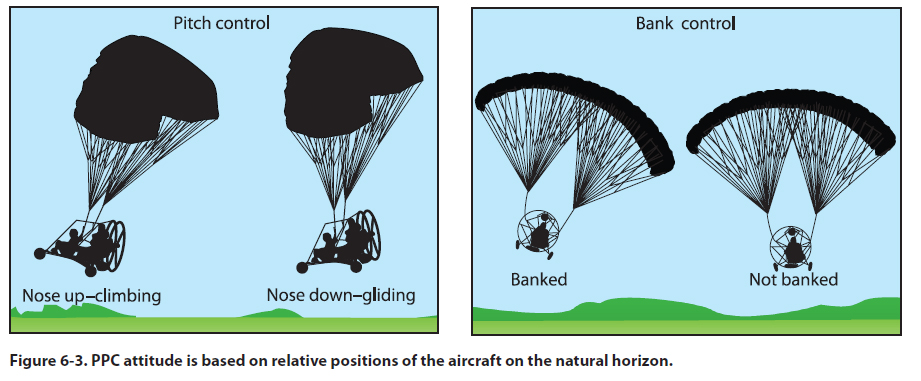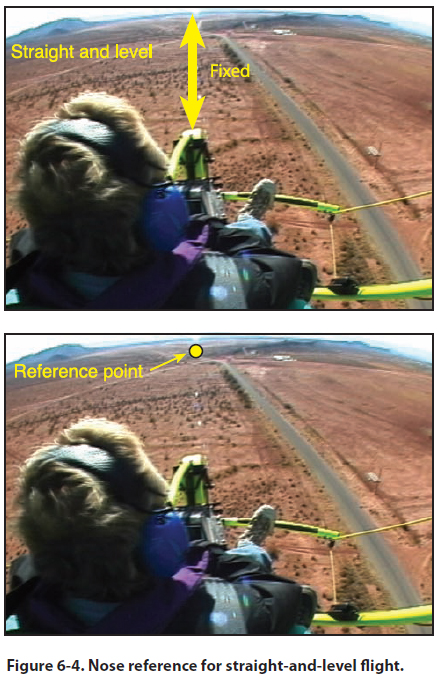|
Chapter 6 — Basic Flight Maneuvers
Attitude Flying
In a PPC, flying by attitude means visually establishing
the aircraft’s attitude with reference to the natural
horizon. [Figure 6-3] Attitude is the angular difference
measured between an aircraft’s axis and the line of the
Earth’s horizon. Pitch attitude is the angle formed by
the longitudinal axis of the aircraft and the horizon.
Bank attitude is the angle formed by the lateral axis
with the horizon.

In attitude flying, the PPC pilot controls two components:
pitch and bank.
• Pitch control is the control of the PPC about the
lateral axis by using the throttle to raise and
lower the nose in relation to the natural horizon.
• Bank control is control of the PPC about the
longitudinal axis by use of the PPC steering
controls to attain a desired bank angle in
relation to the natural horizon.
Straight-and-Level Flight
It is impossible to emphasize too strongly the necessity
for forming correct habits in flying straight and
level. All other flight maneuvers are in essence a deviation
from this fundamental flight maneuver. Perfection
in straight-and-level flight will not come of
itself. It is not uncommon to find a pilot whose basic
flying ability consistently falls just short of minimum
expected standards, and upon analyzing the reasons
for the shortcomings to discover that the cause is the
inability to properly fly straight and level.
Straight-and-level flight is flight in which a constant
heading and altitude are maintained. It is accomplished
by making immediate and measured corrections for
deviations in direction and altitude from unintentional
slight turns, descents, and climbs. Level flight, at first,
is a matter of consciously fixing the relationship of
the position of some portion of the PPC, used as a
reference point, with the horizon. In establishing the
reference points, place the PPC in the desired position
and select a reference point. No two pilots see
this relationship exactly the same. The references will
depend on where the pilot is sitting, the pilot’s height
(whether short or tall), and the pilot’s manner of sitting.
It is, therefore, important that during the fixing
of this relationship, you sit in a normal manner; otherwise
the points will not be the same when the normal
position is resumed.
In learning to control the aircraft in level flight, it is
important to use only slight control movements, just
enough to produce the desired result. Pilots need to
associate the apparent movement of the references
with the forces which produce it. In this way, you can
develop the ability to regulate the change desired in
the aircraft’s attitude by the amount and direction of
forces applied to the controls.
The pitch attitude for level flight (constant altitude) is
usually obtained by selecting some portion of the aircraft’s
nose as a reference point, and then keeping that
point in a fixed position relative to the horizon. [Figure
6-4] Using the principles of attitude flying, that position
should be cross-checked occasionally against the
altimeter (if so equipped) to determine whether or not
the pitch attitude is correct. If altitude is being gained
or lost, the pitch attitude should be readjusted in relation
to the horizon and then the altimeter rechecked to determine if altitude is now being maintained. The application
of increasing and decreasing throttle is used
to control this attitude.

In all normal maneuvers, the term “increase the pitch
attitude” implies raising the nose in relation to the horizon
(by increasing power); the term “decreasing the
pitch attitude” means lowering the nose (by decreas- ing power). While foot controls do have an effect on
altitude, they are not typically used as a control for
flying straight and level. A PPC must be capable of
maintaining altitude to tolerances using the controls
as designed.
Anytime the wing is banked, even very slightly, the
aircraft will turn. In a PPC the pilot has no useful
reference to measure bank angle like an airplane or
weight shift control aircraft where the wing tips are
visible in relation to the horizon. The objective of
straight-and-level flight is to detect small deviations
from laterally level flight as soon as they occur, necessitating
only small corrections. Reference to the magnetic
compass or GPS, if so equipped, can be made
to note any change in direction; however, the visual
reference of a point on the horizon with a point on the
aircraft such as the front wheel or instrument panel
will typically be used for sport pilot training.
Continually observing the nose to align the heading
should be avoided. The pilot must spend more time
scanning for air traffic than focusing on heading. This
helps divert the pilot’s attention from the aircraft’s
nose, prevents a fixed stare, and automatically expands
the pilot’s area of vision by increasing the range
necessary for the pilot’s vision to cover.
Straight-and-level flight requires almost no application
of control pressures if the aircraft is properly
trimmed to fly straight and the air is smooth. Some
PPCs will have a directional trim control which adjusts
the tension in a control line to make it fly straight.
Each PPC manufacturer has a unique design for their
particular aircraft. The pilot must not form the habit
of constantly moving the controls unnecessarily. You
must learn to recognize when corrections are necessary,
and then make a measured response. Tolerances
necessary for passing the PPC practical test are ±10
degrees heading and ±100 feet altitude. Students may
initially start to make corrections when tolerances are
exceeded but should strive to initiate a correction before
the tolerances are exceeded, such as starting correction
before the tolerance is ±5 degreees heading
and ±50 feet altitude.
Since the PPC does not have an elevator to control the
pitch, immediate minor adjustments should be made
while flying close to the ground. In flying a low approach
(flying straight and level over the centerline of
the runway at a low but specified distance from the
ground), think of the throttle as the coarse and slow
response altitude control, and application of both
steering controls (flare) as the fine adjustments to altitude adjustment. Throttle has a slight delay between
implementation and response in increasing altitude;
flare relatively quickly increases altitude but can only
hold altitude changes temporarily (about 2 seconds).
This would be like applying flaps on an airplane if no
elevator control was available.
While trying to maintain a constant altitude, especially
when close to the ground, you can fly with about onethird
flare. By holding a small flare, if you encounter
downdrafts, you can immediately add a large portion
of flare to lift you back to the desired altitude. If the
PPC begins to climb, then you can reduce the amount
of the flare to return to the desired altitude, until you
can adjust your throttle position again.
Common errors in the performance of straight-andlevel
flight are:
• Attempting to use improper reference points on
the aircraft to establish attitude.
• Forgetting the location of preselected reference
points on subsequent flights.
• Attempting to establish or correct aircraft
attitude using flight instruments rather than
outside visual reference.
• Overcontrol and lack of feel.
• Improper scanning and/or devoting insufficient
time to outside visual reference.
• Fixation on the nose (pitch attitude) reference
point.
• Unnecessary or inappropriate control inputs.
• Failure to make timely and measured control
inputs when deviations from straight-and-level
flight are detected.
• Inadequate attention to sensory inputs in
developing feel for the PPC.
|

